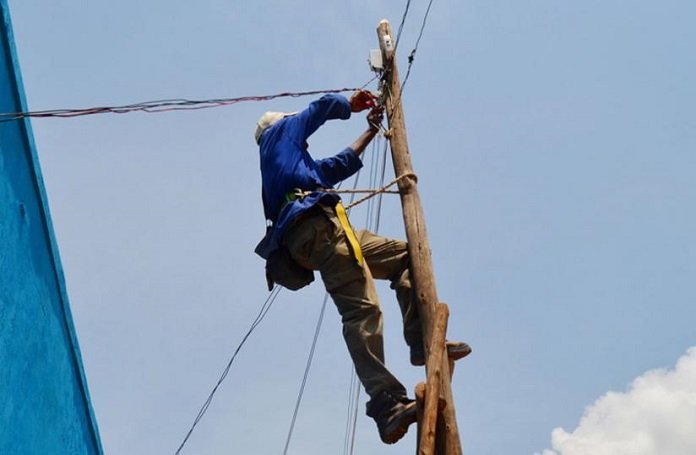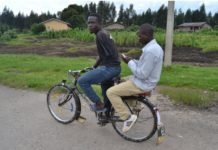
Tuesday dawn has its heavy mist hanging over Kidandari Village like life here depended on it. From a distance as the mist melts, one is able to see hazy forms of structures; buildings, trees, and electric poles.
Tuesday dawn has its heavy mist hanging over Kidandari Village like life here depended on it. From a distance as the mist melts, one is able to see hazy forms of structures; buildings, trees, and electric poles.
True, Kidandari is in the rural end of Shyira Sector in Nyabihu District. But it is also true that this village has several households with electricity. The electric poles visible in the mist are lined from a small river known as Mwana.
This river is the source of the electricity that, strangely, belongs not to any energy company, but rather, a school dropout: Christopher Nziyonsenga.
The 23-year-old Senior Three dropout is currently famous in the village, thanks to his electrical engineering genius.
Nziyonsenga and his young brothers lost their mother in 2005 when he was in Senior One but struggled until he completed O-Level.
He dropped out in 2007 after failing to secure tuition for A-Level education and started a new life out of school to work and take care of his three siblings.
Months later, Nziyonsenga opted for technical and vocational training hoping he could acquire hands-on skills.
“I majored in construction with my heart always beeping for electrical engineering. It was my wish to become an electrician,” he says as he leads Saturday Times to his area of operation.
Nziyonsenga confidently explains how things are done at his mini dam – yes, he has one – to generate electricity.
The ‘genius’ started using a bicycle dynamo for a turbine to churn water in Nyarubandu stream around his home.
“I started making electricity when I started vocational studies. With the skills I had from O-Level, I could use a bicycle dynamo to light the house we lived in,” Nziyonsenga says.
The energy he tapped from the dynamo would be directed to the transformer to light a bulb in their home.
“I was using this way to light our house and light was enough, we forgot about darkness or buying candle or paraffin,” he says, adding that he tried to help his neighbours get electricity but he could not exceed two houses.
His dream was to further his research and make sure his village has power from his invention. This has been realised.
As he continued his research, Nziyonsenga shifted from the stream to Mwana River. And, to expand his activities, he started a turbine made from brake compartments of a vehicle and other old machines.
The way forward
Nziyonsenga says one day he met an engineer operating at Musarara hydro power plant in Gakenke District.
“The man was walking and met me busy working on electricity on the site, he asked how I thought of the project and assessed my skills. He took me to his plant and offered me a job, now I am an operator there,” he says
“I used the money I was paid to expand my project and, from the job, I managed to gain additional skills,” he says.

How he does it
Nziyonsenga has made his own turbine from iron sheets and turns mechanical engine into electrical one to generate electricity. He can now generate 2 kilowatt from a power house in Nyabihu.
The lad has another power house in Nyabinoni Sector in Muhanga District.
A turbine is a simple device with few parts that churns flowing fluids (liquids or gases) to produce electrical energy.
Nziyonsenga says he is planning to work with a university graduate to set up a control system as he currently uses poor system to manage generated power.
“When I have that control system, I will be able to control everything. There is an engineer who will help me sort out the matter,” he says.
Currently, Nziyonsenga works closely with beneficiaries so that no heavy electronics are plagued because when it happens, it affects the distribution.
Households pay Rwf20,000 each to get connected to electricity and thereafter Rwf2,000 per month for the energy they consume.
Nziyonsenga says the area he lives in is mountainous and has many rivers that can be used to generate more energy and supply it to communities without electricity.
“With more rivers around, the opportunity is huge. I am planning to first add more energy in this area before I can work on other rivers as long as I get the means,” he says.
Nziyonsenga earns more than Rwf300,000 per month, which he uses to extend his project. He also pays fees for his siblings.
“I am grateful with the progress thus far, this couldn’t have happened if I hadn’t been patient and hard-working. There are times things went wrong but I never got discouraged,” he says.
Challenges
Nziyonsenga’s main challenge is insufficient funding to extend his project. He believes that once he gets financial support, he can connect more households to electricity.
Kimbali King, Nziyonsenga employer, says the youthful electrician is always ahead of his colleagues at work.
“He is more innovative and creative and performs differently from other employees. He is capable of becoming a senior engineer once he is trained and supported,” he said.
Local leaders and engineers laud the contribution of Nziyonsenga’s innovation to the energy sector.
Simon Pierre Habineza, the head of electricity network in Ngororero and Nyabihu districts, said small plants made by individuals are of great importance as they help remote areas get electricity.
He said 3 kilowatt made by Nziyonsenga are enough to help at least 50 households with electricity.
“We work with those people and once we get connected we can support them and like that one in Nyabihu who produces 3 kilowatt he can increase it to more than 5 kilowatt and supply to more people,” Habineza said.
He added that such people also need advice on how they can improve their skills and further their creativity and innovations.
Beneficiaries of Nziyonsenga’s invention are grateful that he has helped them light their homes.
“We used to stay in darkness whenever we had no money to buy candles but now we pay him Rwf2,000 per month and we are able to charge our phones,” Joseph Twahirwa, from Kidandari Village.
Rwanda’s current installed capacity is 147MW and government targets 563MW by 2017, which will see at least 70 per cent households countrywide with access to electricity.
Source: The New Times











